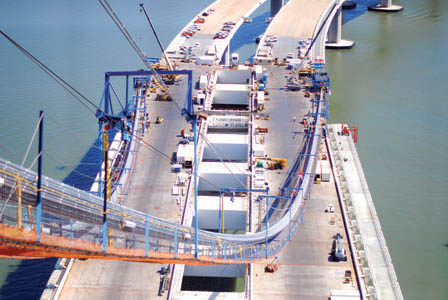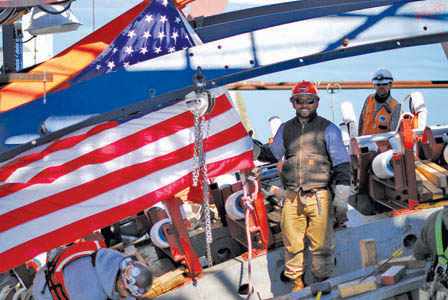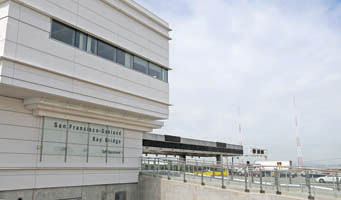Construction of the new East Span of the San Francisco-Oakland Bay Bridge reached another important milestone last month when ironworkers lifted into place the 137th and final strand of the main cable for the signature self-anchored suspension (SAS) portion of the new bridge.

Shown from the top of the 525-foot single tower, the main cable for the new Bay Bridge East Span measures 2.6 feet in diameter and is comprised of 137 hexagonal strands. Photo by Mark Jones
By John Goodwin
Published: May, 2012
Construction of the new East Span of the San Francisco-Oakland Bay Bridge reached another important milestone last month when ironworkers lifted into place the 137th and final strand of the main cable for the signature self-anchored suspension (SAS) portion of the new bridge.
To mark the completion of the intricate cable placement process, an American flag came along for the ride on the final strand’s nearly mile-long journey—from the cable anchorage at the eastern end of the SAS to the top of the 525-foot tower, down again for a quick loop around the western end of the structure, and then back for a return trip to the tower crest and the eastern anchorage. As Old Glory approached, crews pounding the nearly 5,300-ton cable into a custom-built saddle atop the tower stopped for a few moments to hold a private celebration and pose for commemorative photographs.
With the 137 strands now connected to the anchor rods that lock them into place, crews have begun the cable compaction process, in which a specially crafted device squeezes the strands together to eliminate any loose space between them, leaving behind a tight sinew measuring 2.6 feet in diameter. The compactor, which began its work at the top of the tower, is compressing the strands every 1.5 meters along the length of the cable.
Unlike traditional suspension bridges where the cables are anchored into the ground, a self-anchored suspension bridge’s cable is anchored in the road decks. When completed, the cable will act like a giant sling, supporting the weight of the deck. Placement of the new cable, which is the longest single-looped suspension bridge cable in the world, began last December when a state-of-the-art hauling system, designed specifically for this operation, began carrying the first coiled bundle of high-tensile steel wires. For the next three months, crews worked day and night, installing up to four strands each day.
Once compaction is complete, smaller suspender cables will be installed to connect the main cable to the twin 2,047-foot-long bridge decks before the weight of the bridge is transferred this summer to the cable system from the temporary supports built to hold up the decks in the interim.
Placement of the final cable strand came just weeks after transportation officials hoisted a giant pair of scissors to cut a ceremonial red ribbon and officially open for business a new, seismically safe Toll Operations Building at the Bay Bridge toll plaza. San Mateo County Supervisor Adrienne Tissier, who also serves as chair of the Metropolitan Transportation Commission (MTC) and Bay Area Toll Authority (BATA), presented a key to the striking white facility to Caltrans District 4 Director and MTC Commissioner Bijan Sartipi.
Designed by HNTB Corp. and constructed by San Francisco-based Swinerton Builders, the new building pays tribute to the new East Span, with exterior fins evoking the shear link beams on the tower of the new bridge, which is slated to open to traffic in September 2013.

Workers attached an American flag to the final strand of the new bridge’s main cable for its nearly mile-long voyage from anchorage to anchorage. Photo by Mark Jones

The architecture of the new Toll Operations Building borrows design cues from the Bay Bridge East Span that will open in 2013. Photo by Peter Beeler, MTC

